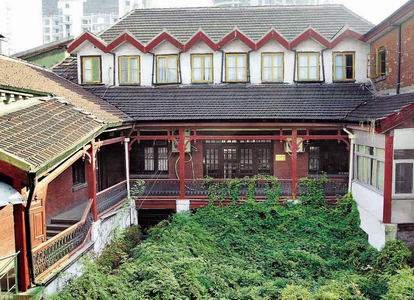Shanghai Daily news


The three-story mansion on Weihai Road, built by the Qiu
brothers in the 1920s, used to be home to the Minli Middle School. The school
moved to the other end of the road in September and the house is to be converted
into a club.
They were two brothers who so missed life in the country that their city
homesite - bought with the fortune they had acquired accidentally - was filled
with wild animals and crocodiles, writes Michelle Qiao.
The house at 412
Weihai Road is a hidden treasure, hidden behind dirty auto parts shops and -
until a few weeks ago - filled with schoolchildren. Incredible as it seems on
today's noisy, traffic-filled street, it used also to be the site of an idyllic
menagerie created by brothers whose ancestors came from the lakes and mountains
of China.
Green ivy covers the walls of the three-story building, making it
look like a medieval castle. A spacious fenced yard completely shelters the
building from bustling Weihai Road outside. The castle-like structure appears to
have come from another world, especially with the high-rise, luxurious Four
Seasons Shanghai hotel in the background.
Finely carved stonework, arched
colonnades and wooden doors with mosaics of colored glass are some of the
exquisite architectural details that recall the building's former glory.
The
"castle," which also used to house Minli Middle School, was built between 1920
and 1930 by two brothers, Qiu Beishan and Qiu Weiqing. In fact, they originally
constructed two similar buildings, one for each of them. The school demolished
the building to the west in 1990 for making space for new classrooms.
"Qiu's
ancestors once lived as fisherfolk in the countryside and later became farmer
heroes in the uprisings in East China's Shandong Province," says Shen Fuxu, an
expert on architectural history at Tongji University.
At the end of the 19th
century, the Qiu brothers left their rural hometown for Yangzhou in neighboring
Jiangsu Province before moving to Shanghai, driven to the city to seek work by
the poor life they were living. Finally, they found jobs in a German paint
factory.
"After World War I broke out, the German boss had to fold the
business to return home. So, he sold the paint stockpiled in the factory to the
brothers at a very low price," says Shen. "The war disrupted sea trade and the
price of the paint soared to amazing heights. The brothers sold the paint and
they became rich men overnight."
With the profits from the paint, they bought
land covering less than one hectare on what is now Weihai Road. They built their
two "castles" and set up their own paint factory called "Guang Da Yuan" which
made them one of the top four paint tycoons in Shanghai in those days.
"It's
very interesting that the wealthy brothers found they still missed their former
'wild' life among the mountains and lakes," says Shen. "They began keeping
tigers, snakes and pangolins in the garden. Then they built a large pond in
which to raise crocodiles and followed this with a huge pigeon house for 2,000
pigeons. They also raised more than 10 horses for riding and hunting. That was
really rare, even among the tycoons of old Shanghai."
It was said that the
pigeons blocked out the sun over Weihai Road when they were released every
morning. A third-generation Qiu descendant used to participate in races
conducted by the city's pigeon racing association and won many
prizes.
However, Shen says, the magnificent houses also attracted
robbers.
"Once, two robbers climbed in and forced one of the Qiu's
daughters-in-law at gunpoint to open the safe," says Shen. "Coincidentally, the
family had put a 'rainbow' of fake jewelry in the safe - samples sent from a
jewelry store for a daughter's upcoming marriage. The robbers got away with all
the fake jewelry."
Later, the fortunes of the Qiu family declined. In 1940,
the Qiu brothers sold their "castles" to the Minli Middle School and the animals
were either sold or sent away.
"They made a fortune by accident and they were
not good at keeping it because of their generous character - like most northern
Chinese," says Shen.
Last year the Minli Middle School made miniature models
of the building as a souvenir for its centenary anniversary.
"Us Secretary of
State Colin Powell saw the house on his way to the Shanghai TV Station in 2001
during his visit. He came in and stood in front of the house for quite a while,"
says Wu Jue, a Chinese teacher for the school's alumni office who has worked in
the school for 30 years.
But the school moved into new premises at the other
end of Weihai Road in September. The Jing'an government now plans to renovate
the remaining "castle" and turn it into a club.
"Many alumni have told me
they miss the house and so do I," says Wu. "My grandparents-in-law held their
wedding ceremony with other couples in the house which was also used as a club
for then Kuomintang leader Chiang Kai-shek in the 1930s. I also lived in a loft
in the house after my marriage where I gave birth to my daughter. The house is
so nice and cool in summer and warm in winter. It's part of my life's
memories."
Today the empty "castle" looks unusually tranquil and a bit weird,
even mysterious.
"We cannot find out what happened to the family afterwards.
There's only a few records about the Qius," says Shen.
So, the old house is
all that remains of the Qiu family who left their home in the wilds of China,
came to Shanghai, made a fortune, built two beautiful homes and then abandoned
them without leaving a trace. Only one lovely house still stands to remind
passers-by of its roller-coaster past.



